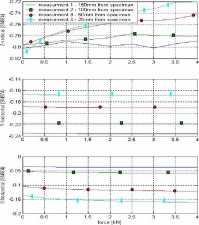2740390132
Diagnostyka - Diagnostics and Structural Health Monitoring l(57)/2011 9
GONTARZ, RADKOWSKI, Magnetic Methods In Diagnosis Of Machines And Infrastructural Objects-A Survey

Fig. 3. Distribution of magnetic filed along the horizontal direction from tlie specimen
as caused by Villaiy effect, even from the distance of up to lOOmin.

Fig. 2. Cliange of magnetization (in Gauss) in a function of force with different measurement distance
During tlie next stage of tlie test, the real specimen was replaced by the artificial source of magnetic field - an electromagnetic yoke. This enabled discovering the distribution of magnetic field’s source in space. The intensity of the magnetic field was decreasing exponentially, which is presented in Figurę 3.
The conducted research has demonstrated the existence of magnetoelastic phenomena for the designed samples. We have proven that the qualitative change of the magnetic field occurs in a situation when a sample subjected to stretching interacts with the surrounding magnetic field, and such a cliange is siinilar to the cliange of the field in a situation when the electromagnetic yoke is tlie source.
The tests have demonstrated that without using any additional extemal source of magnetic field it is possible to describe the State of preiailing mechanical stress, with varied correlation between the values of the magnetic field’s components and the intensity of the generated magnetic field which depends on the direction of measurement.
The issues which have been analyzed here give hope diat the method of passive magnetic diagnosis. which relies on quantitative and qualitative cliange of own magnetic field of an object, can offer a new possibility of detecting the early phases of hazardous conditions in teclinical objects. Few steps were madę to get closer this opportunity [20. 21].
5. CONCLUSIONS
Further work related to development of the magnetic technique, which allows early fault condition detection in technical objects madę of ferromagnetic materials, sliould be carried on. Exploiting die fact tliat w ithout the use of additional extemal sources of magnetic field there exists a possibility of presenting the estimates of mechanical stress condition, with the correlation between the intensity of the changes which generate magnetic field depending on measurement direction, creates a possibility for rise of a new universal and efficient diagnostic method. The paper points out that innovative passive magnetic tecluiique, which rely on quality and quantity clianges of magnetic field, can bring good results to diagnosis of complex teclmical objects.
By controlling the plastic and die elastic rangę of specimen deformation, we have proven tlie existence of a relation between stress and magnetization degree, which is strictly connected with defonnation and degree of effort. In our test three perpendicular directions were used, which clearly shows that changes of magnetization arising from the mechanical stress differ depending on the measurement direction. Additionally, the distribution of the eigemnagnetic field generated by a tensioned Steel object offers hope for a possibility of remote stress assessment but the measurement settings should be properly chosen. In such a situation the properties of the technical object, for example the materiał, shape, structure and dimensions should be taken into consideration.
The paper was prepared on the basis of researches conducted within a project „Monitoring of Technical State of Construction and Evaluation of its Lifespan” (MONIT). Project is co-financed by the European Regional Development Fund in the Operational Programme Innovative Economy (PO IG 1.2)
Wyszukiwarka
Podobne podstrony:
8 Diagnostyka - Diagnostics and Structural Health Monitoring l(57)/2011 GONTARZ,
10 Diagnostyka - Diagnostics and Structural Health Monitoring 1(57)/2011 GONTARZ,
Diagnostyka - Diagnostics and Structural Health Monitoring 1(57)/2011 3 GONTARZ,
4 Diagnostyka - Diagnostics and Structural Health Monitoring l(57)/2011 GONTARZ,
Diagnostyka - Diagnostics and Structural Health Monitoring l(57)/2011 5 GONTARZ,
6 Diagnostyka - Diagnostics and Structural Health Monitoring l(57)/2011 GONTARZ,
Diagnostyka - Diagnostics and Structural Health Monitoring 1(57)/2011 GONTARZ, RADKOWSKI, Magnetic M
Diagnostyka - Diagnostics and Structural Health Monitoring l(57)/2011 11 GONTARZ,
13 Diagnostyka - Diagnostics and Structural Health Monitoring 1(57)/2011 MENDROK, MAJ, UHL, Laborato
14 Diagnostyka - Diagnostics and Structural Health Monitoring 1(57)/2011 MEND ROK, MAJ, UHL, Laborat
15 Diagnostyka - Diagnostics and Structural Health Monitoring 1(57)/2011 MEND ROK, MAJ, UHL, Laborat
16 Diagnostyka - Diagnostics and Structural Health Monitoring 1(57)/2011 MENDROK, MAJ, UHL, Laborato
17 Diagnostyka - Diagnostics and Structural Health Monitoring 1(57)/2011 MEND ROK, MAJ, UHL, Laborat
18 Diagnostyka - Diagnostics and Structural Health Monitoring 1(57)/2011 MENDROK, MAJ, UHL, Laborato
Diagnostyka - Diagnostics and Structural Health Monitoring 1(57)/2011 Spis treści / Contents Szymon
Diagnostyka - Applied Structural Health, Usage and Condition Monitoring’ 3(63)/2012 Cholewa, Amarowi
Diagnostyka - Applied Structural Health, Usage and Condition Monitoring’ 3(63)/2012
10 Diagnostyka - Applied Structural Health, Usage and Condition Monitoring’ 3(63)/2012 CISZEWSKI, BU
Diagnostyka - Applied Structural Health, Usage and Condition Monitoring’ 3(63)/2012
więcej podobnych podstron